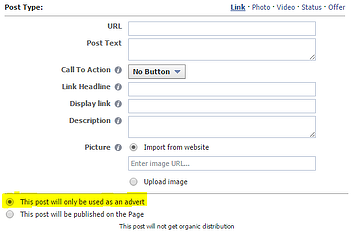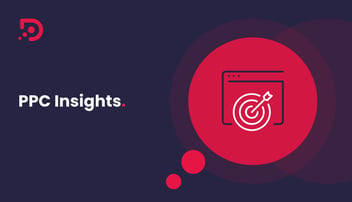In case you need an introduction, Facebook is the biggest social media platform in the world. It has a stonking 2.4 billion users and generates billions of dollars in ad revenue (just shy of 34 so far in 2018).
It offers almost unmatched opportunity for advertisers. It gives the best ROI on ad spend according to 58% of businesses who engage in social media marketing, joint top with LinkedIn and way above the competition (Twitter is in third place: 39%).
In short, Facebook is a platform you need to be familiar with.
This article introduces Facebook lead ads: an advertising format within the platform which are hugely effective at generating leads, as their name suggests.
After reading this article you will know:
- How to get started with Facebook lead ads
- How to decide effective campaign objectives
- What the Facebook tracking pixel is and how to implement it
- Which metrics to monitor
What is a Facebook lead ad?
This is a Facebook lead ad:
Aside from the stuff in the red boxes - a custom CTA and clear signposting that this is marketing content - the post looks the same as other content in your Facebook news feed.
Facebook lead ads sit within an expansive suite of advertising products available through the platform: sponsored mentions, domain ads, offer ads, video ads, and various others. A strong focus on lead generation distinguishes lead ads from the other types, and they make a welcome addition to any successful B2B Facebook marketing strategy.
What are Facebook lead ads for?
The eponymous page of the Facebook Business website captures their appeal nicely:
"Get more customers with lead ads. Lead ads can help make it easy for your customers and potential customers to connect with your business."
Facebook shine a spotlight on three methods for generating leads:
- Growing your mailing list
- Learning more about customers via enquiry forms
- Offering coupons and promotions
While this list is not exhaustive, their prominence suggests Facebook considers them most suited to the ad type. We will run through other campaign objectives later in this guide.
Why are Facebook lead ads so effective?
A lead ad is designed to be quick and easy to interact with, while remaining unintrusive. They are a seamless part of the Facebook experience.
They can serve their full function within the Facebook platform, meaning people are less likely to drop off while engaging.
The forms automatically populate with information the user has made available to Facebook, too, meaning fewer fields need to be filled in. Again: designed to keep people engaged.
Because they have been designed to generate leads by a platform whose profitability relies largely on ad revenue, you can be confident that their design and application will be effective.
How to get started with Facebook lead ads
Facebook have made the process effortless. It’s in their interest to get you set up as quickly as possible, after all.
Here’s what you need:
- Ad copy
- Visual collateral
- Questions for your ad
- A link to your privacy policy
Ad copy should quickly and clearly communicate the value proposition of your ad: don’t make prospects hunt for a reason to engage.
With the visual collateral, you have the option to use an image, a carousel of multiple images, or video.
For the questions, generic fields like name and email let you capture information about prospective leads, and these can be combined with custom questions to gain more insight and further qualify the lead.
Facebook require advertisers to have a published privacy policy on their website. This serves two purposes: to put customers at ease, and to help Facebook cover their tracks in case any more scandals unfold.
With lead ads you have the option of providing welcome screen content, too. This is an optional page that can appear before your ad to give further context and information.
Creating a Facebook lead ad
To create a lead ad, head to the ‘Ad Tools’ tab in Business Manager. Click ‘Create Promotion’, then scroll down to the ‘Get more leads’ box:
Click that, and a box will pop up with fields to fill in on the left, and a live preview on the right:
This is where you put the information we mentioned in the previous section. ‘Email’ and ‘Full name’ are selected by default, and various other options are accessible in the ‘Show more options’ section:
- Street address
- Date of birth
- Gender
- Job title
- Company name
Custom short questions can be used to grab specific information from prospects.
There is an art when creating adverts of only collecting information that you really need to qualify a lead. Unless you’re going to send a physical item, or use a postcode to check they fall within a relevant catchment area, don’t ask for a user's physical address.
B2B advertisers are more likely to ask for job title and company name to check the prospect falls within the relevant departmental bucket for the campaign.
It is also important to keep it short. ‘Full name’ is one field, ‘First name’ and ‘Last name’ get the same information but take twice the effort to provide. By consolidating fields and only asking for vital information, you reduce the risk of prospects dropping off midway through completing your form.
The Facebook tracking pixel: what it is and how to use it
A Facebook tracking pixel is required to make the most of Facebook adverts, including lead ads. The Pixel is a small piece of code which lets you track ad-related actions on your website.
According to Facebook, it lets you “make sure that your ads are being shown to the right people”, “build advertising audiences”, and “unlock additional Facebook advertising tools”.
Allen Finn explains the Facebook tracking pixel best: "The Facebook pixel allows you to optimise for almost any type of on-site action, provided you put the damn thing on your website."
Installing the Facebook tracking pixel
To be in line with B2B Facebook best practices, we recommend installing the Facebook tracking pixel.
The pixel is designed to be quick and easy to set up. First you click ‘Get Started’ in the ‘Facebook pixel’ section of your events manager.
You’re then given some code to copy and paste into the header section of your website. If you use a popular Content Management System (CMS) like Wordpress, or you update your site content through Google Tag Manager, you can benefit from streamlined configuration options.
Once the code is installed, you set up a few options to determine which events you’d like to track and how you’d like to track them:
You can choose whether to track on page load or inline action. The former is good for page visits; the latter is good for actions that take place somewhere on a page, like clicked 'add to cart'.
The full list of trackable events is as follows:
- Purchase
- Lead
- Complete registration
- Add payment info
- Add to basket
- Add to wishlist
- Initiate checkout
- Search
- View content
Within these events exists the opportunity to gain a detailed understanding of prospects’ interaction with and movement through your website.
More detailed instructions for configuring the Facebook tracking pixel can be found here.
How to test the Facebook tracking pixel is working
The Facebook Pixel Helper is a Google Chrome extension that tests whether Facebook tracking pixels are installed and functioning correctly. You can download and install it here.
This tool protects you from painstakingly configuring your Pixel, only to find out later that it's not been working.
Note: the helper is only available as a Google Chrome extension, so if you prefer other browsers, you'll have to begrudgingly use Chrome for testing purposes.
If your pixel is configured correctly you will see a success message:
If not, you will see an error message:
The Facebook support pages offer extensive troubleshooting advice for Facebook tracking pixel errors.
Choosing campaign objectives for your lead ads
To be as effective as possible, all ads need to be associated with specific campaign objectives. This will influence their design, the Calls to Action (CTAs) used, and various other factors.
Facebook identify three overarching objectives for adverts on their platform, shown below:
- Awareness: Objectives that generate interest in your product or service.
- Consideration: Objectives that get people to start thinking about your business and look for more information about it.
- Conversions: Objectives that encourage people interested in your business to purchase or use your product or service.
Other more granular objectives exist within these umbrellas:
- Increasing reach*
- Boosting engagement*
- Increasing conversions
- Generating leads*
- Raising attendance at events
- Initiating communication with prospective customers*
- Getting people to claim an offer*
- Getting people to install your app
- Increasing engagement with an app
- Qualifying customers to drive transactions
Lead ads lend themselves particularly well to the objectives marked with a * above.
But what else can they do?
We touched on Facebook’s suggested lead ad objectives earlier: growing your mailing list, collecting information with enquiry forms, and offering coupons and promotions. Below are some other applications for Facebook lead ads:
- Scheduling appointments
- Registering for events
- Downloading whitepapers
- Providing price quotes
- Signing up for webinar
- Arranging consultations
- Arranging product demos
- Booking test drives
- Growing your mailing list: number of signups
- Collecting information with enquiry forms: number of submissions, quality of information submitted
- Offering coupons and promotions: number of coupons distributed, number of coupons redeemed, number of promotions signed up for
- Scheduling appointments: number of appointments booked, number of appointments cancelled
- Registering for events: number of registrants, number of attendees
- Downloading whitepapers: number of downloads, number of opens (if trackable)
- Providing price quotes: quotes requested, quotes followed up on
- Signing up for webinar: number of sign-ups, number of attendees
- Arranging consultations: consultations booked, consultations attended
- Arranging product demos: demos booked, demos attended
- Booking test drives: test drives booked, test drives attended
Each of these will be applicable to certain businesses and contexts. Test drives are quite obviously limited to car dealerships, but many of the other objectives have wider applications.
Whitepapers and webinars will appeal to B2B companies, for example.
Because of their variety, we think Facebook lead ads are one of the best ad types for B2B Facebook advertising.
When choosing a campaign objective, be aware of the balance between more volume and higher intent. The former is the default, but higher intent may be better suited to certain campaigns. Ads designed to capture leads with higher intent include unique features designed to weed out lower intent prospects.
Key metrics to monitor for Facebook lead ads
To ensure you aren’t throwing money into the Facebook advertising ether, you need to monitor the performance metrics of your ads.
Facebook's ad platform offers a bunch of metrics you can use to track the performance of your advertising campaigns. Each of the campaign objectives outlined above has associated metrics, some of which you can track through Facebook, others which you will need to cross reference with insights from elsewhere (number of appointments cancelled, for example).
If you see a lot of sign-ups or bookings, but many cancellations and, as a result, low overall engagement, this may be a prompt to refine the process for following up leads.
Here are some other things to keep an eye on:
- Audience composition and relevance: Facebook has access to an incredible amount of user data, so while their Custom Audience Targeting algorithms offer high levels of sophistication, it’s important to check in occasionally and make sure ads are reaching people in your audience, and in relevant similar audiences.
- Cost per Lead (CPL): whether this be cost per newsletter sign-up or cost per webinar sign-up, understanding the cost of each lead compared to other platforms is a good indicator of whether this is money well spent.
How to engage with generated leads
Regardless of campaign objective you should follow up with leads quickly, while your advert and business are fresh in their mind.
Facebook’s adverts can integrate with your Customer Relationship Management (CRM) tools for effortless connection with your existing processes. Direct integrations are available for a range of platforms, including Mailchimp, Marketo, and Salesforce Marketing Cloud. Indirect integrations are available through tools such as Zapier.
Integration means you don’t have to download leads from Facebook manually. Instead they are sent automatically to your CRM, meaning you can connect straight away through your current workflow.
If you still have questions about Facebook lead ads, their extensive support pages will be able to help. For now, we leave you with some case studies of companies who have seen success through Facebook lead ad campaigns.
Facebook lead generation examples
The Royal Danish Theatre saw a whopping 47% of their newsletter signups come from a Facebook lead ad campaign, a result which ended up surprising both the theatre and their agency.
The Milwaukee Bucks saw 33% of leads buy a product and 20% of leads upgrade an existing product, representing a 36x return on ad spend.
Thinkful were able to increase their lead volume by 2.7x, and their revenue by 2.5x as a result.
These are just a sample of tons of case studies in the Facebook Business Hub ‘Success’ section, too. They seem pretty confident that businesses can achieve success through their platform; we’re confident that we can help your business to do the same.
Facebook lead ads are one of the best ad types for B2B Facebook advertising. If you think your company could benefit from their implementation - speak to us today!




